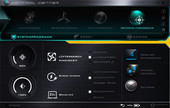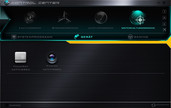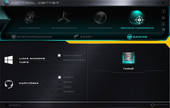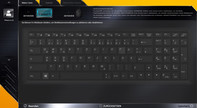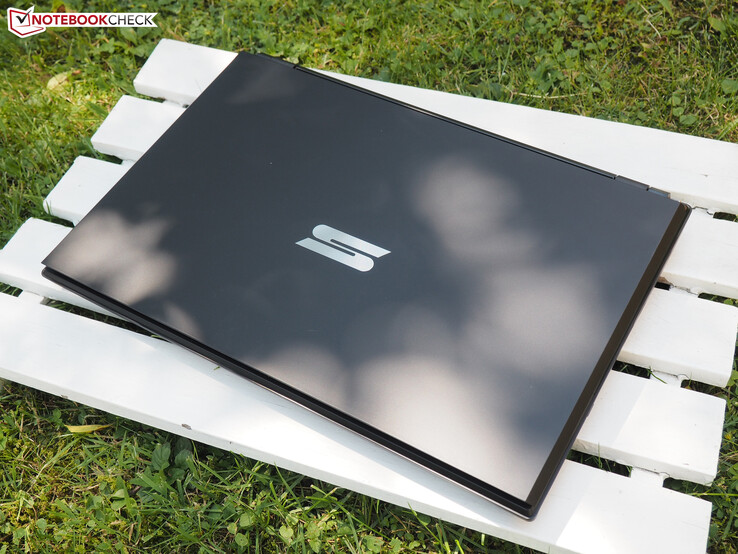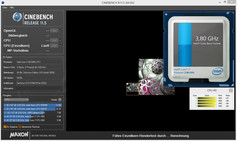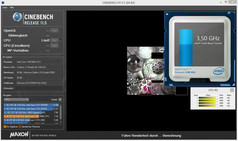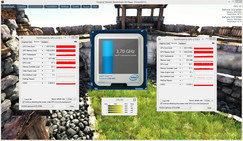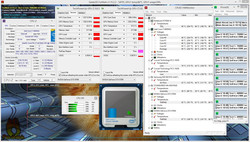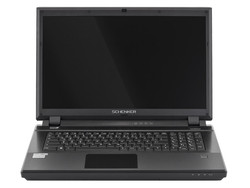Schenker W724 (Clevo P370SM-A) Notebook Review
For the original German review, see here.
Unlike most SLI notebooks, it is possible to customize the Schenker Workstation in various ways, including the memory (4-32 GB DDR3 RAM @1866 MHz), the optical drive, the wireless adaptor or the operating system. It is really impressive that there are a number of possible storage solutions inside the 17-inch chassis. In addition to the two 2.5-inch slots for HDDs, SSDs and hybrid drives, you also get two mSATA slots that can be equipped with solid-state drives from 120 to 1000 GB (Samsung or Crucial). The chassis is not completely new, so you do not get the modern M.2 technology, which would support SSDs with a PCIe interface (no limitation of 500-550 MB/s).
There is no criticism in terms of the processors. The CPUs are still based on the Haswell architecture, but all versions – except for the base model Core i5-4210M – are fast enough for current and upcoming games (Core i7-4710MQ up to Core i7-4940MX). Our review unit is powered by the Core i7-4810MQ, which is not too expensive and works well with the other components.
The graphics card of the entry-level version priced at 2199 Euros (~$2495) is the top model from Nvidia. You can also get an SLI configuration with two GTX 880M, GTX 970M or GTX 980M chips if you spend between 28 and 790 Euros (~$32 to ~$900) extra. From a price-performance ratio point of view, we would recommend the GeForce GTX 970M SLI in our review configuration. Our tested model costs almost 3000 Euros (~$3405), which is neither too expensive nor a bargain compared to the SLI competition.
Case
We are already familiar with the chassis from the Schenker XMG P724 that was launched in 2014 and its predecessor XMG P723. With a thickness of 50 millimeters (~1.97 in) and a weight of 4.3 kg (~9.5 lb/ including battery, dual-GPU, mSATA-SSD and HDD), the Clevo P370SM-A Barebone is positioned between the Aorus X7 Pro and the MSI GT80 (23 millimeters/3.1 kg and 49 millimeters/4.9 kg (~0.9 in/7 lb and ~1.9 in/11 lb), respectively). While the first notebook also has a 17-inch display and a similar GPU configuration, the latter is equipped with an 18-inch panel and the even more powerful GeForce GTX 980M SLI. More information about the chassis, the connectivity and the input devices is available in the following article. We will therefore directly jump to the Display section.
Display
Although Schenker also offers 17-inch notebooks with IPS screens (e.g. XMG U705), the W724 is only available with a TN panel). Despite the comparatively stable picture, the Chi Mei N173HGE-L11 has a hard time against an IPS product when you look at the viewing angles and the color accuracy. The CalMAN screenshots below show a strong blue cast ex-works, which can fortunately be removed with calibration or the use of our ICC file. The grayscale, gamma value and saturation also benefit significantly from calibration.
| |||||||||||||||||||||||||
Brightness Distribution: 86 %
Center on Battery: 301 cd/m²
Contrast: 1038:1 (Black: 0.29 cd/m²)
ΔE Color 11.24 | 0.5-29.43 Ø5
ΔE Greyscale 11.84 | 0.57-98 Ø5.3
95% sRGB (Argyll 1.6.3 3D)
62% AdobeRGB 1998 (Argyll 1.6.3 3D)
68% AdobeRGB 1998 (Argyll 2.2.0 3D)
95.4% sRGB (Argyll 2.2.0 3D)
66.3% Display P3 (Argyll 2.2.0 3D)
Gamma: 2.43
Other issues of the panel are the slightly grainy picture impression and the second-class brightness distribution. We can see some screen bleeding at the edges, and it is annoying that the display illumination shines through the panel and the notebook frame, particularly when you consider the over 2000 Euros (~$270) price tag. Speaking of annoying: It is a known fact that the Chi Mei N173HGE-L11 has issues with Nvidia laptops without switchable graphics, and there will be thin horizontal stripes on dark backgrounds – we reported this back in 2013 (XMG P723).
| SCHENKER W724 Chi Mei N173HGE-L11 (CMO1720) | MSI GS70-2QE16SR51 CMN N173HGE-E11 | Asus G751JY-T7009H LG Philips LP173WF4-SPD1 (LGD046C) | SCHENKER XMG P724 Chi Mei N173HGE (CMO1720) | Aorus X7 Pro AU Optronics B173HW01 V5 (AUO159D) | MSI GT80-2QES32SR311BW XJY7J_184HL (SDC4C48) | |
|---|---|---|---|---|---|---|
| Display | -9% | -7% | -10% | -3% | -11% | |
| Display P3 Coverage | 66.3 | 61.1 -8% | 66.4 0% | 60.4 -9% | 67.9 2% | 60.7 -8% |
| sRGB Coverage | 95.4 | 85 -11% | 85.3 -11% | 83.7 -12% | 88.7 -7% | 82.8 -13% |
| AdobeRGB 1998 Coverage | 68 | 62.1 -9% | 62.1 -9% | 61.3 -10% | 64.9 -5% | 60.6 -11% |
| Screen | 1% | 8% | -1% | 1% | 9% | |
| Brightness middle | 301 | 251 -17% | 329 9% | 350 16% | 318 6% | 341 13% |
| Brightness | 293 | 249 -15% | 326 11% | 325 11% | 283 -3% | 305 4% |
| Brightness Distribution | 86 | 84 -2% | 93 8% | 84 -2% | 82 -5% | 77 -10% |
| Black Level * | 0.29 | 0.28 3% | 0.47 -62% | 0.37 -28% | 0.54 -86% | 0.34 -17% |
| Contrast | 1038 | 896 -14% | 700 -33% | 946 -9% | 589 -43% | 1003 -3% |
| Colorchecker dE 2000 * | 11.24 | 11.19 -0% | 3.95 65% | 10.69 5% | 3.79 66% | 5.15 54% |
| Greyscale dE 2000 * | 11.84 | 4.57 61% | 3.36 72% | 10.95 8% | 2.35 80% | 6.34 46% |
| Gamma | 2.43 91% | 2.38 92% | 2.46 89% | 2.69 82% | 2.37 93% | 2.35 94% |
| CCT | 15320 42% | 14550 45% | 5961 109% | 13524 48% | 6775 96% | 6895 94% |
| Color Space (Percent of AdobeRGB 1998) | 62 | 55 -11% | 56 -10% | 56 -10% | 58 -6% | 53 -15% |
| Color Space (Percent of sRGB) | 95 | |||||
| Total Average (Program / Settings) | -4% /
-2% | 1% /
4% | -6% /
-4% | -1% /
-0% | -1% /
4% |
* ... smaller is better
Apart from these issues, the panel of the Schenker W724 leaves a good to very good impression. A brightness of 293 cd/m² is right between the Aorus X7 Pro (283 cd/m²) and the MSI GT80 (305 cd/m²), which means that thanks to the anti-reflective display surface; you can actually use the 17-inch device in the outdoors, although it is not very comfortable because of the weight.
However, back to the display. The contrast of the W724 is slightly better than the MSI GT80, which also manages a result higher than 1000:1. The Aorus X7 Pro is quite far behind because of the significantly worse black value (0.54 vs 0.29 to 0.34 cd/m²). All things considered, we would call the display usable, but many users are going to expect an IPS display in the luxury segment.
Performance
TThe Schenker W724 is without a doubt a device from the desktop replacement category. In addition to the connectivity, upgradeability and expandability, respectively, the performance does not have to hide behind a ‘real’ PC.
Processor
At the heart of the notebook is a 22 nm processor from Intel’s Haswell generation. While the base model Core i5-4210M has only two native cores, the more expensive chips are quad-cores. The TDP varies between 37 and 57 watts depending on the CPU, and the ‘normal’ quad-cores (4710MQ, 4810MQ & 4910MQ) are specified at 47 watts. Schenker could have waived the high-end model Core i7-4940MX when you consider the exorbitant price. The efficient 37-watt chip Core i7-4712MQ on the other hand does not really meet the high-end expectations. All processors support the Hyperthreading technology, which means that every native core has a virtual counterpart, so the i7 chips can execute up to eight threads simultaneously.
The utilization of the automatic Overclocking is limited in the case of the Schenker W724. 3.6-3.8 GHz in single-core scenarios roughly correspond with the maximum Turbo Boost of the i7-4810MQ, but the clock will drop from 3.4-3.6 to 3.2-3.3 GHz when you stress multiple cores for a prolonged time. However, there is definitely no throttling during standard Windows tasks and gaming. This phenomenon is (similar to many other notebooks) limited to maximum load, where the Core i7-4810MQ only manages around 2.0 GHz.
Still, the CPU performance of the Schenker W724 is excellent despite some Turbo issues. The high-end device manages 696 points in the Cinebench R15 Multi-Core test, which is a few percent ahead of many competitors that have either less-expensive CPUs or bigger Turbo issues. Only the Core i7-4980HQ of the MSI GT80 manages a small advantage, but this is not noticeable in practice. The notebook ranking is very similar in the Single-Core test (see table).
System Performance
The combination of a solid-state drive, dual-GPU, quad-core CPU and a decent amount of memory results in an excellent system performance. 6171 points are enough for the Schenker W724 to secure a top spot amongst the high-end and gaming notebooks. The Aorus X7 Pro is on par with 6141 points, while the MSI GT80 managed more than 6600 points thanks to the four SSDs in a RAID-0 configuration.
| PCMark 7 Score | 6171 points | |
Help | ||
Storage Devices
The primary storage solution of the review unit is the 500 GB version of Samsung’s 850 EVO. We selected the ‘small version’ since mSATA-SSDs have hardly any performance disadvantages compared to their 2.5-inch siblings and the additional price is not too high. You can only see small differences when you compare the results with the predecessor. The Samsung 840 EVO (Schenker XMG P724) has already scratched the 500 MB/s mark in the sequential write test of the AS SSD benchmark. The access times and the performance with small files are very similar. However, this is not a criticism, since the 840 EVO had been already one of the fastest SSDs on the market. The mSATA drive is accompanied by a 2 TB hard drive; Samsung's SpinPoint M9T manages sequential transfer rates of almost 130 MB/s, which is a very good result for a conventional hard drive.
GPU Performance
If you plan to use the Schenker W724 mainly for gaming and not for professional tasks, you should avoid the Quadro K5100M and select one or two GeForce GPUs instead. Unlike the GTX 880M, which is not up to date anymore because of the Kepler technology, the models from the 900-series are based on the Maxwell architecture and consume less power or are faster at the same consumption. The choice between the GTX 970M and the GTX 980M is basically a question of your wallet. An SLI configuration of the GTX 980M, for example, costs around 700 Euros (~$795) more than two of the weaker siblings – way too much when you consider the pretty mediocre performance increase. While the GTX 970M has 6 GB GDDR5 video memory (192-bit interface) and 1280 CUDA cores, the GTX 980M is equipped with 8 GB GDDR5 video memory (256-bit interface) and 1536 shaders. Both GPUs are based on the GM 204 chip that is manufactured in a 28 nm process.
| 3DMark 11 Performance | 14252 points | |
| 3DMark Ice Storm Standard Score | 143818 points | |
| 3DMark Cloud Gate Standard Score | 25872 points | |
| 3DMark Fire Strike Score | 10827 points | |
Help | ||
We have already mentioned that the additional charge for the GTX 980M SLI over the GTX 970M SLI only pays off for performance enthusiasts. Both 3DMark 11 as well as the Fire Strike test of the new 3DMark show that the GTX 970M SLI in the review unit of the Schenker W724 is just around 20% slower than the much more expensive MSI GT80. A single GTX 970M is roughly 60% slower than the SLI configuration, and a single GTX 980M is beaten by around 30%. The review unit is also 10 to 20% faster than two GTX 880M GPUs. Overall, the results are very similar to the Aorus X7, which is slightly slower in some scenarios because of the Turbo utilization and the driver version.
| 3DMark | |
| 1920x1080 Fire Strike Score (sort by value) | |
| SCHENKER W724 | |
| MSI GS70-2QE16SR51 | |
| Asus G751JY-T7009H | |
| SCHENKER XMG P724 | |
| Aorus X7 Pro | |
| MSI GT80-2QES32SR311BW | |
| 1280x720 Cloud Gate Standard Score (sort by value) | |
| SCHENKER W724 | |
| MSI GS70-2QE16SR51 | |
| Asus G751JY-T7009H | |
| SCHENKER XMG P724 | |
| Aorus X7 Pro | |
| MSI GT80-2QES32SR311BW | |
| 3840x2160 Fire Strike Ultra Score (sort by value) | |
| SCHENKER W724 | |
| 3DMark 11 - 1280x720 Performance (sort by value) | |
| SCHENKER W724 | |
| MSI GS70-2QE16SR51 | |
| Asus G751JY-T7009H | |
| SCHENKER XMG P724 | |
| Aorus X7 Pro | |
| MSI GT80-2QES32SR311BW | |
Gaming Performance
Even two GTX 970M chips are not always fast enough for gaming in 4K, despite the enormous performance. A combination of high details and 3840x2160 pixels will result in smooth gameplay in some games (“Dirt Rally”, “Fifa 15”, …), but very demanding games like “Battlefield 4” or “The Witcher 3” suffer from annoying (micro) stutters.
| low | med. | high | ultra | 4K | |
| Battlefield 4 (2013) | 48.7 | ||||
| Fifa 15 (2014) | 96 | ||||
| Call of Duty: Advanced Warfare (2014) | 153.9 | 115.4 | 106.8 | 65.6 | |
| Assassin's Creed Unity (2014) | 117.1 | 110.5 | 83.6 | 46 | |
| Far Cry 4 (2014) | 117.4 | 114.3 | 101.7 | 89.9 | |
| Dragon Age: Inquisition (2014) | 161.3 | 147.8 | 100.3 | 69.8 | |
| Evolve (2015) | 189.3 | 178.3 | 130.7 | 117.2 | |
| Battlefield Hardline (2015) | 163.1 | 155 | 143.1 | 97.7 | |
| Dirt Rally (2015) | 374.4 | 168 | 135.6 | 83.3 | 71.4 |
| The Witcher 3 (2015) | 205.1 | 144.7 | 84.8 | 47.6 | 28.4 |
The native display resolution is not a problem for the SLI configuration. Even the highest details and anti-aliasing are possible on the Schenker W724. It does not matter if you play “Assassin's Creed Unity”, “Far Cry 4”, “Call of Duty Advanced Warfare” or “Dragon Age Inquisition”: The notebook sometimes even manages more than 100 fps (“Evolve”) in the ultra-setting. All the results from the ultra and the 4K benchmarks show that the second GTX 970M increases the performance by roughly two thirds.
| The Witcher 3 | |
| 3840x2160 High Graphics & Postprocessing (Nvidia HairWorks Off) (sort by value) | |
| SCHENKER W724 | |
| Schenker W504 | |
| Schenker W504 | |
| 1920x1080 Ultra Graphics & Postprocessing (HBAO+) (sort by value) | |
| SCHENKER W724 | |
| Schenker W504 | |
| Schenker W504 | |
| Dirt Rally | |
| 3840x2160 High Preset (sort by value) | |
| SCHENKER W724 | |
| Schenker W504 | |
| Schenker W504 | |
| 1920x1080 Ultra Preset AA:4x MS (sort by value) | |
| SCHENKER W724 | |
| Schenker W504 | |
| Schenker W504 | |
| Battlefield Hardline - 1920x1080 Ultra Graphics Quality (DX11) AA:4x MS (sort by value) | |
| SCHENKER W724 | |
| Schenker W504 | |
| Schenker W504 | |
| Evolve - 1920x1080 Very High Graphics Quality AA:1TX SM (sort by value) | |
| SCHENKER W724 | |
| Schenker W504 | |
| Schenker W504 | |
| Dragon Age: Inquisition - 1920x1080 Ultra Graphics Quality AA:2x MS (sort by value) | |
| SCHENKER W724 | |
| MSI GS70-2QE16SR51 | |
| Asus G751JY-T7009H | |
| MSI GT80-2QES32SR311BW | |
| Far Cry 4 - 1920x1080 Ultra Graphics Quality AA:SM (sort by value) | |
| SCHENKER W724 | |
| MSI GS70-2QE16SR51 | |
| MSI GT80-2QES32SR311BW | |
| Assassin's Creed Unity - 1920x1080 Ultra High Graphics Quality AA:4x MS (sort by value) | |
| SCHENKER W724 | |
| MSI GS70-2QE16SR51 | |
| Asus G751JY-T7009H | |
| MSI GT80-2QES32SR311BW | |
| Call of Duty: Advanced Warfare - 1920x1080 Extra / On (Cache Shadow Maps Off), 2x Supersampling AA:2x SM (sort by value) | |
| SCHENKER W724 | |
| MSI GT80-2QES32SR311BW | |
| Fifa 15 - 3840x2160 High Preset (sort by value) | |
| SCHENKER W724 | |
| Schenker W504 | |
| Schenker W504 | |
| Battlefield 4 - 3840x2160 High Preset (sort by value) | |
| SCHENKER W724 | |
| Schenker W504 | |
| Schenker W504 | |
Emissions
Note: All the following measurements were performed with activated SLI.
System Noise
The noise development has significantly improved since the last hardware generation. While the GPU combination of the Schenker XMG P724 (GTX 880M SLI) reached up to 55 dB(A) in 3D scenarios, our measurement device shows "only" 47 dB(A) for our review unit of the Schenker W724. The main reason should be the improved efficiency of the Maxwell architecture, so the heat development is reduced. The performance of the 17-inch laptop is particularly good compared to the Aorus X7 Pro and the MSI GT80, which can reach up to 58-60 dB(A). However, we cannot call the notebook quiet, 44-47 dB(A) in 3DMark 06 are clearly audible without ambient noises.
We can also notice optimizations while idling. While the fans of the predecessor were always active, they are now temporarily deactivated, so you will only hear a subtle murmur from the HDD. However, this does require optimal conditions (no load, energy-saving mode, …). The cooling solution usually produces 34-37 dB(A), which is not really good, even for a high-end notebook. The Aorus X7 Pro, for example, manages an average of just 32 dB(A) (36 dB(A) @MSI GT80). A problem is the jumpy fan control: The fans sometimes spin up and create more than 40 dB(A) without any apparent reason, which can be very annoying, especially with light workloads (office, web browsing, …). We had already noticed this issue in the review of the XMG P724, even though the situation is not quite as bad this time. The barebone manufacturer should definitely improve this.
Noise Level
| Idle |
| 31.2 / 37.2 / 42.4 dB(A) |
| HDD |
| 31.2 dB(A) |
| DVD |
| 38.8 / dB(A) |
| Load |
| 44.4 / 47.4 dB(A) |
 | ||
30 dB silent 40 dB(A) audible 50 dB(A) loud |
||
min: | ||
| SCHENKER W724 GeForce GTX 970M SLI, 4810MQ | MSI GS70-2QE16SR51 GeForce GTX 970M, 4720HQ | Asus G751JY-T7009H GeForce GTX 980M, 4710HQ | SCHENKER XMG P724 GeForce GTX 880M SLI, 4810MQ | Aorus X7 Pro GeForce GTX 970M SLI, 4870HQ | MSI GT80-2QES32SR311BW GeForce GTX 980M SLI, 4980HQ | |
|---|---|---|---|---|---|---|
| Noise | -1% | 8% | -16% | -4% | -6% | |
| Idle Minimum * | 31.2 | 29.6 5% | 33.6 -8% | 40 -28% | 29.5 5% | 34.2 -10% |
| Idle Average * | 37.2 | 34.4 8% | 34.8 6% | 40.4 -9% | 32.1 14% | 36.2 3% |
| Idle Maximum * | 42.4 | 39.4 7% | 35.2 17% | 48.4 -14% | 41 3% | 37.8 11% |
| Load Average * | 44.4 | 47.2 -6% | 36.8 17% | 50.2 -13% | 52.3 -18% | 47.6 -7% |
| Load Maximum * | 47.4 | 55.8 -18% | 43.8 8% | 55.4 -17% | 57.9 -22% | 59.8 -26% |
* ... smaller is better
Temperature
Except for the high CPU result (the Core i7-4810MQ reached around 96 °C (~205 °F) in the stress test despite throttling) there is no criticism for the temperatures. After one hour maximum load with the tools FurMark and Prime, the two GPUs warmed up to reasonable 83 and 87 °C (~181 and 189 °F), respectively. The Schenker P724 suffered from GPU throttling in this scenario (whereas the CPU did not drop below its nominal clock). The surface temperatures are decent. Up to 45 °C (~113 °F) at the top and up to 48 °C (~118 °F) at the bottom are easily surpassed by the rivals (more than 60 °C/~140 °F @Aorus X7 Pro & MSI GT80). There is hardly any warming while idling; 31 °C (~88 °F) indicate a convenient operation.
(-) The maximum temperature on the upper side is 45.4 °C / 114 F, compared to the average of 40.4 °C / 105 F, ranging from 21.2 to 68.8 °C for the class Gaming.
(-) The bottom heats up to a maximum of 48.1 °C / 119 F, compared to the average of 43.2 °C / 110 F
(+) In idle usage, the average temperature for the upper side is 31.5 °C / 89 F, compared to the device average of 33.8 °C / 93 F.
(±) The palmrests and touchpad can get very hot to the touch with a maximum of 39.8 °C / 103.6 F.
(-) The average temperature of the palmrest area of similar devices was 28.9 °C / 84 F (-10.9 °C / -19.6 F).
| SCHENKER W724 GeForce GTX 970M SLI, 4810MQ | MSI GS70-2QE16SR51 GeForce GTX 970M, 4720HQ | Asus G751JY-T7009H GeForce GTX 980M, 4710HQ | SCHENKER XMG P724 GeForce GTX 880M SLI, 4810MQ | Aorus X7 Pro GeForce GTX 970M SLI, 4870HQ | MSI GT80-2QES32SR311BW GeForce GTX 980M SLI, 4980HQ | |
|---|---|---|---|---|---|---|
| Heat | -23% | 11% | 10% | -30% | -1% | |
| Maximum Upper Side * | 45.4 | 56.3 -24% | 43.3 5% | 42 7% | 61.2 -35% | 43.8 4% |
| Maximum Bottom * | 48.1 | 68.6 -43% | 48 -0% | 42.8 11% | 59.1 -23% | 63 -31% |
| Idle Upper Side * | 33.8 | 37.9 -12% | 27.7 18% | 30.4 10% | 43.9 -30% | 29.6 12% |
| Idle Bottom * | 35.1 | 39.8 -13% | 27.9 21% | 30.8 12% | 46.8 -33% | 30.4 13% |
* ... smaller is better
Speakers
Information about the sound system is available in the review of the XMG P724.
Energy Management
Power Consumption
You can clearly see the effects of the missing switchable graphics when you look at the power consumption. While laptops with Optimus usually stay below 30 watts while idling, the Schenker W724 consumes between 32 and 46 watts, which explains the poor battery runtimes. The device is at least more frugal than the review configuration of the XMG P724. Instead of 155 watts (first scene of 3DMark 06) and 326 watts (maximum load), the new model pulled only 122 and 276 watts, respectively, from the socket. The 330-watt power adaptor should be working at its limit with two GTX 980M cards as well as an even faster CPU (up to 329 watts @MSI GT80).
| Off / Standby | |
| Idle | |
| Load |
|
| SCHENKER W724 GeForce GTX 970M SLI, 4810MQ | MSI GS70-2QE16SR51 GeForce GTX 970M, 4720HQ | Asus G751JY-T7009H GeForce GTX 980M, 4710HQ | SCHENKER XMG P724 GeForce GTX 880M SLI, 4810MQ | Aorus X7 Pro GeForce GTX 970M SLI, 4870HQ | MSI GT80-2QES32SR311BW GeForce GTX 980M SLI, 4980HQ | |
|---|---|---|---|---|---|---|
| Power Consumption | 38% | 28% | -14% | 5% | -11% | |
| Idle Minimum * | 32.2 | 15.7 51% | 22 32% | 36.8 -14% | 29 10% | 34.3 -7% |
| Idle Average * | 39.8 | 21.7 45% | 27 32% | 42.3 -6% | 34.8 13% | 41.9 -5% |
| Idle Maximum * | 45.6 | 26.3 42% | 32.6 29% | 47.3 -4% | 40.6 11% | 49.3 -8% |
| Load Average * | 122 | 108.7 11% | 93.3 24% | 154.6 -27% | 132 -8% | 140.2 -15% |
| Load Maximum * | 276 | 166.9 40% | 212.8 23% | 326 -18% | 276 -0% | 328.6 -19% |
* ... smaller is better
Battery Runtime
The battery runtimes of the W724 are – to put it mildly – pretty mediocre, despite the large 8-cell battery (89 Wh, 5900 mAh). 1.5 up to 3 hours is reminiscent of the early gaming notebooks, but neither the Aorus X7 Pro nor the MSI GT80 is any better. The result: You should get a single-GPU notebook if you are often on the road.
| SCHENKER W724 GeForce GTX 970M SLI, 4810MQ | MSI GS70-2QE16SR51 GeForce GTX 970M, 4720HQ | Asus G751JY-T7009H GeForce GTX 980M, 4710HQ | SCHENKER XMG P724 GeForce GTX 880M SLI, 4810MQ | Aorus X7 Pro GeForce GTX 970M SLI, 4870HQ | MSI GT80-2QES32SR311BW GeForce GTX 980M SLI, 4980HQ | |
|---|---|---|---|---|---|---|
| Battery Runtime | 17% | 19% | -5% | -8% | -23% | |
| Reader / Idle | 179 | 308 72% | 272 52% | 161 -10% | 178 -1% | 191 7% |
| Load | 100 | 61 -39% | 85 -15% | 100 0% | 86 -14% | 48 -52% |
Pros
Cons
Verdict
The P370SM-A Barebone would slowly but surely benefit from an update. Not only the enormous weight and the thick build, but also several details in particular are annoying. Besides the glossy and very sensitive ClickPad, we are talking about the display. Every high-end product in 2015 should be equipped with an IPS panel, which promises wider viewing angles and more accurate colors compared to the TN technology.
Otherwise, the device is mostly impressive. It is not enough for a ‘very good’ in many sections, but the performance of the Schenker is still decent compared to the rivals. Other dual-GPU notebooks like the MSI GT80 or the Aorus X7 Pro are not only louder under load, but also warmer. However, the W724 is only suitable for workstation veterans or ambitious gamers. The short battery runtimes and the bulky chassis will limit users to the desk, and you can argue about the logic of two graphics cards. Classic notebooks with just one dedicated GPU are the best all-rounders in practice, which is shown by the Schenker XMG P505, for instance.
SCHENKER W724
-
06/09/2015 v4(old)
Florian Glaser


 Deutsch
Deutsch English
English Español
Español Français
Français Italiano
Italiano Nederlands
Nederlands Polski
Polski Português
Português Русский
Русский Türkçe
Türkçe Svenska
Svenska Chinese
Chinese Magyar
Magyar
